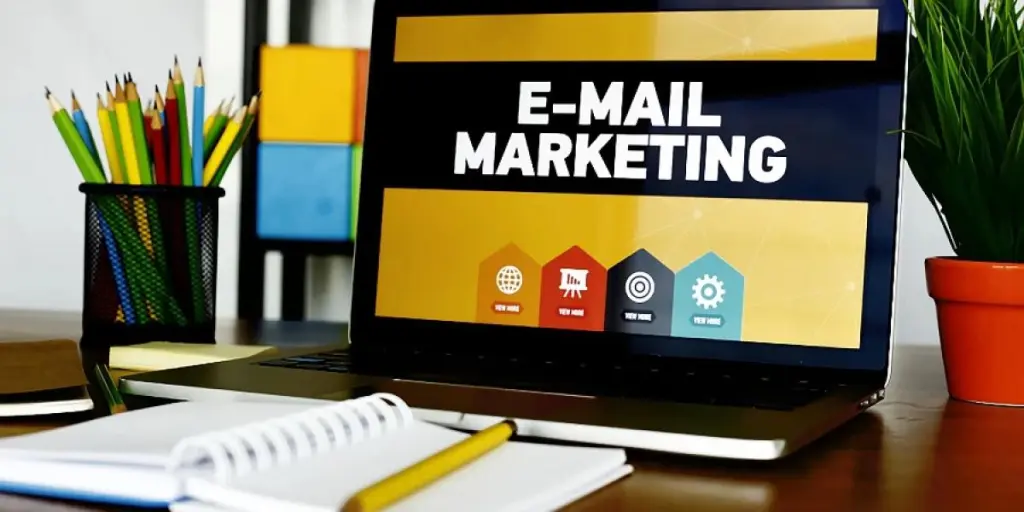Do you think email optimization is a daunting and time-consuming task?
We are here to bust this myth.
The reality is that email optimization just requires attention to detail and a strategic approach. There are numerous strategies and tools available that can streamline the process and maximize your email marketing campaign’s effectiveness.
Let’s see what these strategies are.
Table of Contents
What is email optimization?
12 email optimization strategies
Wrapping up
What is email optimization?
Email optimization refers to steps taken to enhance various aspects of email marketing campaigns in order to achieve better results.
It involves strategically optimizing different elements of emails, such as subject lines, content, design, layout, segmentation, and calls to action, to encourage desired actions from recipients.
Effective email optimization strategies can significantly improve open rates, click rates, conversions, deliverability, and ROI. These are the top KPIs that measure an email campaign’s performance, per an Ascend2 survey.
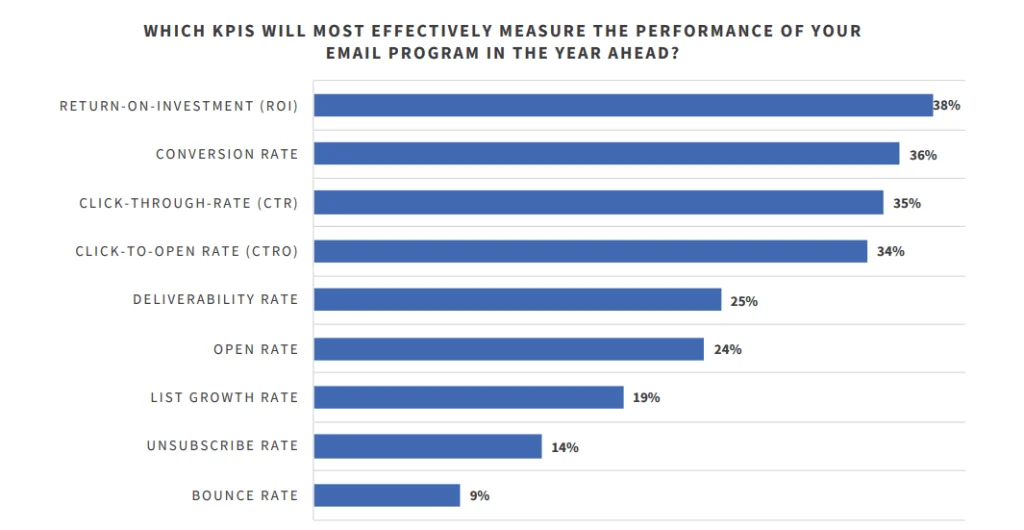
Here’s a case study that illustrates the importance of email optimization strategies.
Saks Fifth Avenue had initially sent an email with a generic 75% discount “for everyone.” Gartner’s analysis showed the email had a low open rate of 19.2%.
By adopting email optimization tactics, such as hyper-targeting (Size 2 to 16 girls’ clothing) and a detailed subject line, the company was able to boost the email open rate to 50%.

12 email optimization strategies
In this section, we will discuss the 12 email optimization strategies that can help you drive results and email marketing ROI.
1. Define your target audience
Getting a 360-degree view of your target audience’s pain points, preferences, and expectations is one of the most important steps in email optimization.
Here are the steps to identify and define your target audience:
- Collect data: Gather relevant data about your existing customers and website visitors. This can include demographic information, purchase history, browsing behavior, and any other relevant data points.
- Conduct market research: Perform market research to gain insights into industry trends, customer needs, and competitor analysis.
- Identify common characteristics: Look for patterns and commonalities among your customer data, such as age, gender, location, income level, job title, interests, and preferences.
- Create buyer personas: Use the data and insights you’ve collected to create detailed profiles or customer personas for each customer segment.
2. Build a high-quality email list
The quality of your email list will determine the effectiveness of your email campaigns.
Here are the steps you can follow to build a high-quality email list:
- Offer valuable gated content: Provide valuable content, such as informative blog posts, e-books, guides, templates, or exclusive offers, in exchange for contact information of your site visitors.
- Create compelling opt-in forms: Design attractive and user-friendly opt-in forms (popups, signup forms) that encourage visitors to subscribe to your email list.
Place these forms prominently on your website, blog, and other online channels. You can also use interactive forms, such as the Wheel of Fortune, to make the signing up process fun.
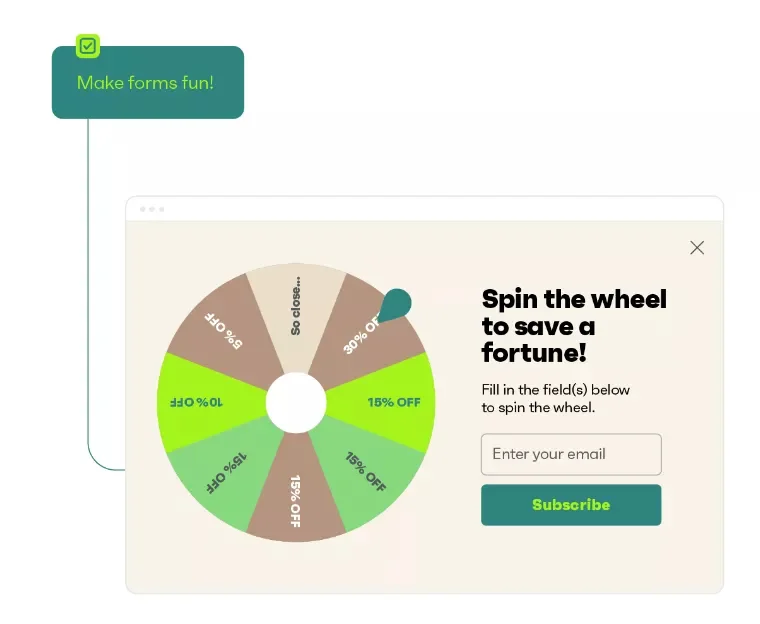
- Use lead magnets: Offer lead magnets, such as checklists, reports, or access to exclusive content.
- Leverage social media: Use your social media platforms to promote your email list and encourage followers to subscribe.
- Host webinars or events: Organize webinars or events related to your industry or niche that require an email opt-in.
3. Optimize subject lines
Being the first thing that recipients see, the email subject line can make or break your email campaign.
Omnisend’s research shows that 35% of recipients open emails solely based on the subject line.
Here are some tips to optimize email subject lines:
- Keep it concise: We recommend keeping the word count between 5 and 7 for best results based on our analysis of the top performing subject lines.
- Create urgency: Use words and phrases that create a sense of urgency or curiosity, such as “limited time,” or “breaking news.”
- Personalize: Include the recipient’s name or other relevant information to make the email feel more tailored and relevant to the individual.
Here’s a personalized subject line from Pink Moon with the recipient’s name:
“Welcome to Pink Moon, Smiles Davis!”
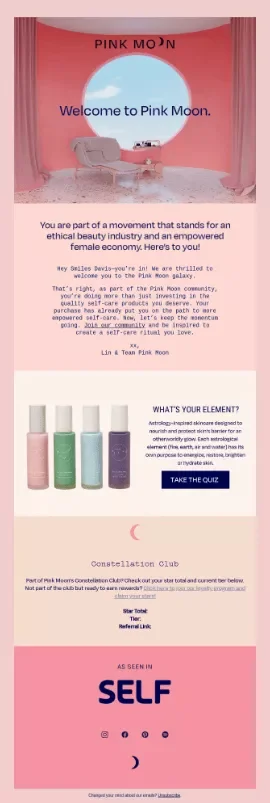
- Avoid spam triggers: Words like “free,” “guarantee,” “buy now,” or excessive use of exclamation marks can raise red flags and reduce deliverability.
- Use numbers: Including numbers or statistics in your subject lines can make them more specific and compelling.
For example, Ritual’s email subject line reads “A cool 20% off.”
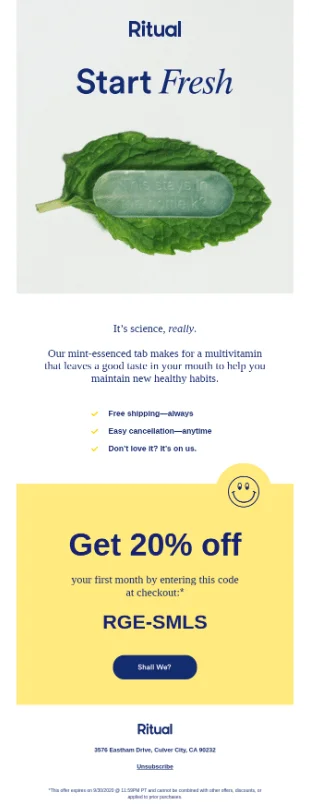
- Test different variations: Perform A/B testing with different subject lines to see which ones generate higher open rates.
You can use Omnisend’s free subject line tester to optimize your subject line in quick time.
4. Optimize email content
If you have defined your target audience and have a firm grasp of their needs/preferences, it becomes easier to create targeted, compelling content.
Here are the steps to follow once you have created buyer personas:
- Determine the goal: The first step is to decide what you want to achieve with the email campaign.
The most common email marketing goals are to:
- Grow subscriber list
- Increase open and click-through-rates
- Boost conversions
- Nurture/retarget existing customers
In this email, you can see how Grammarly highlights the benefits of their Premium plan to encourage the recipients to renew their subscription.

- Inform/educate subscribers
Here is an example of an email with plenty of resources and informative content for designers from Designer Fund:

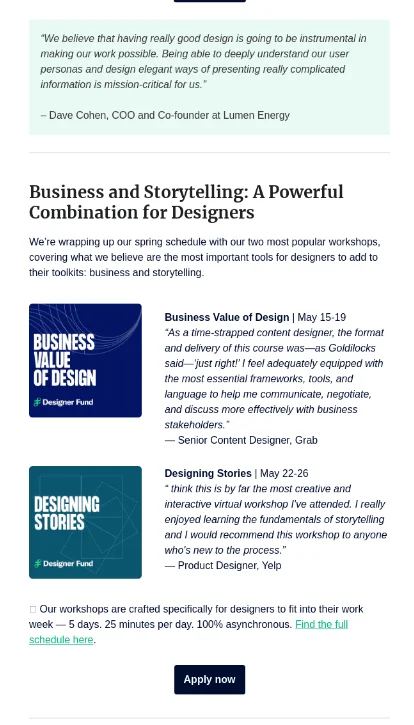
- Select a topic: Consider identifying a specific pain point or gap in the buying cycle that you can address through your content.
- Use headings and subheadings: Break the content into sections and use headings and subheadings to provide a clear structure.
- Font size and formatting: Apply bold or italic styles to highlight important information or keywords.
You can see in this example below that the email draws the readers’ attention to the most important elements using bigger fonts and bold styles.
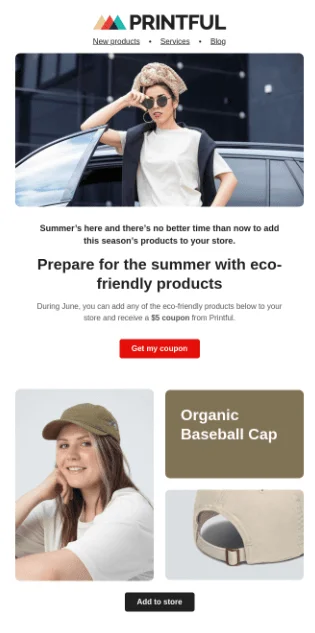
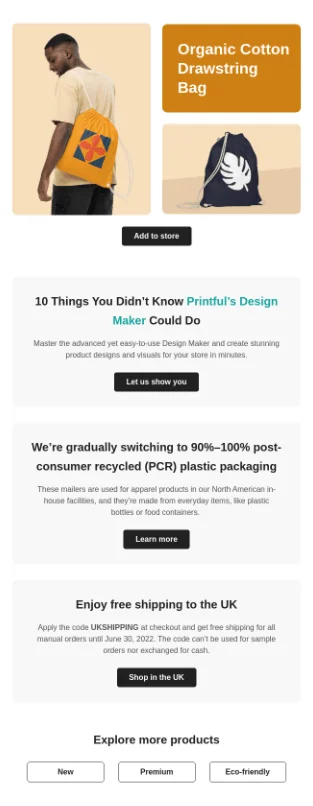
- Optimize color and contrast: It is important to use the right blend of colors and contrast to highlight the visual appeal and make your messages stand out.
Stick to your brand colors if you are unsure of what colors to use, like Dr. Pepper does in its email campaigns:
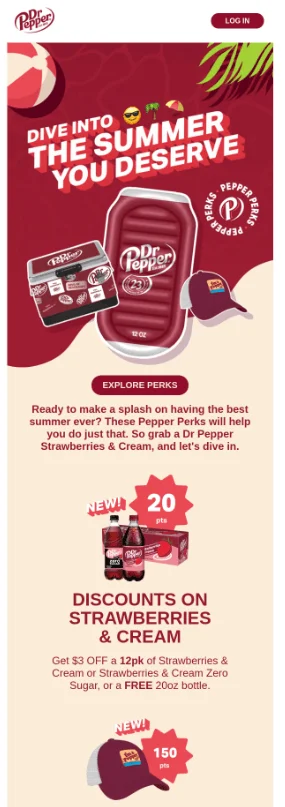
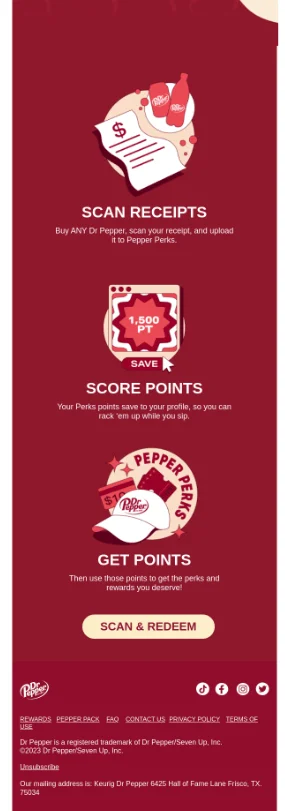
- Order of information: Arrange the content in a logical order that aligns with the reader’s natural reading flow. Place the most critical information or primary call-to-action at the top or in a prominent position to increase its visibility.
5. Optimize email preheader and sender’s name
The next aspect of email optimization relates to email preheader and sender’s name.
The preheader is the text that appears after the subject line in the recipient’s inbox.
This is what the preheader looks like on different devices:

Here are some tips to optimize the email preheader:
- Optimize the length: While there is no fixed formula, we recommend keeping the preheader length between 30 and 80 characters for best results.
- Avoid repetition: While expanding on the subject line, be sure to not repeat the same information.
- Create FOMO: Build curiosity and create a sense of urgency by using words, such as “Limited stock,” or “Offer ends midnight.”
- Include an incentive and a strong CTA: Use action words, such as ‘read,’ ‘download,’ or ‘shop,’ in addition to a relevant incentive to boost conversions.
Here’s a good CTA from Magzter with an action word and an incentive:

6. Optimize images
One of the most important aspects of email optimization is image selection. The right images improve load times, email deliverability, user experience, and branding consistency.
Here are the points to keep in mind when using images in your email campaigns:
- Quality and relevance: Select high-quality images that are relevant to the content and your brand. Focus on the hero image that is typically the first image that the readers see when they open the email, as Paro has done in this email:

- Format: PNG files offer excellent fidelity and can be compressed without affecting the image resolution. You can use GIFs if you want to include animation to capture your audience’s attention.
In this email, Adobe has used animated background to promote its festive collection.

- Background images: You can use background images that complement the content in your email. This email by Chipotle, for example, has a background image that gels perfectly with the content.

7. Provide clear CTAs
Clear calls to action (CTAs) are crucial for email optimization because they direct the recipient’s attention towards the action that you want them to take.
These tips can help you craft compelling CTAs:
- Limit the number of CTAs: While there is no rule on the number of CTAs to include, Omnisend’s research shows that the highest click rates are for emails with 2 to 3 CTAs:
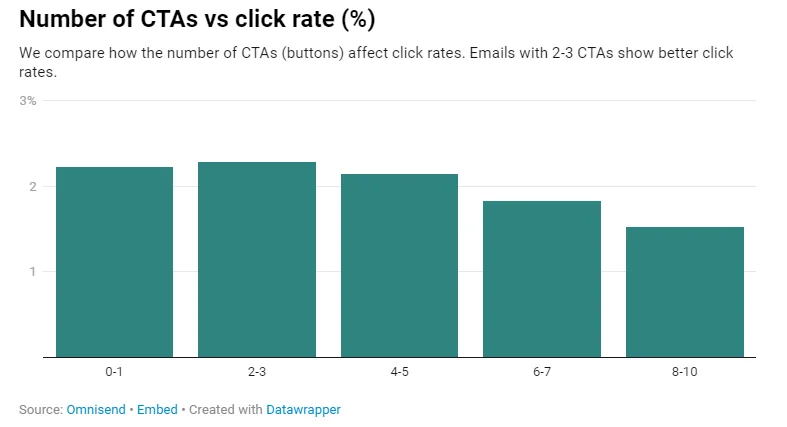
- Focus on placement: Given that the natural reading pattern is from top to bottom and left to right, it makes sense to place the most important email CTAs in these sections.
The primary CTA should be placed in the most prominent section of the email, preferably right next to the top banner image or text.
Yelp’s CTA is hard to miss in this email:
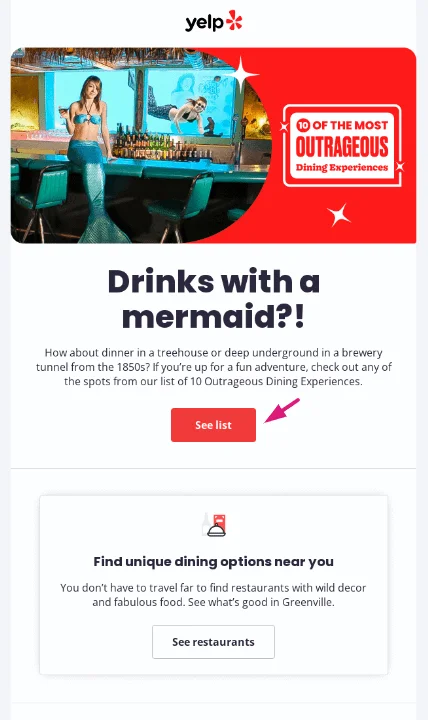
If you are using multiple secondary CTAs, a great way of making each one stand out is to use different colors and styles.
A good example here is the email CTAs from Dyspatch. There are 3 CTAs in the email and each one is in a different color.

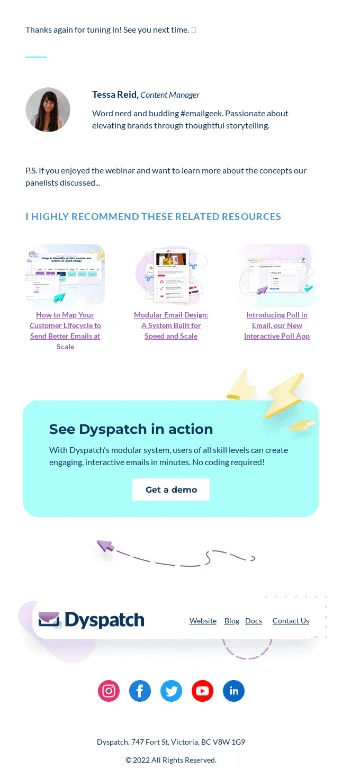
8. Use automation
Along with segmentation, email marketing automation also improves the effectiveness of your campaigns by helping you avoid sending generic emails.
In addition to freeing up your time, automation helps send timely messages to your audience by triggering emails based on specific actions.
You can use pre-built automation workflows, such as the ones Omnisend offers, for all ecommerce campaign types. These include welcoming new subscribers, following up with users who abandoned their carts, cross-selling, or re-engaging inactive subscribers.

9. Use segmentation
Yet another important step involved in email optimization is list segmentation. It allows you to tailor your email content and offers to each segment, leading to higher engagement and conversion rates.
With Omnisend, you can segment your lists at a granular level with multiple attributes and conditions:

10. Optimize emails for mobile
It’s no secret that a majority of emails are opened on mobile devices. This is why it’s important to optimize your emails for mobile viewing.
Some tips to keep in mind to ensure your emails are optimized for mobile:
- Use a responsive design: Ensure that your email content is displayed properly on both large and small screens.
- Keep the email width narrow: The ideal width is between 600 and 650 pixels for your email templates to ensure the email fits well on smaller mobile screens.
Here’s an example of a mobile-optimized email from Toms.

- Use a mobile-friendly font size: Text that is too small can be difficult to read on mobile devices. The minimum font size to use is 13-pt for text and 20-pt for titles.
- Optimize images: Compress and optimize images to reduce their file sizes without compromising on image quality.
- Test across multiple devices: Test your emails across various mobile devices to ensure consistent rendering.
11. Use personalization
Personalization can help you build stronger connections with your audience and improve the effectiveness of your emails.
As mentioned above, you can use multiple segments, such as recipients’ names, shopping behavior, inactive customers, or lifecycle stage to create hyper-personalized messages.
Spotify’s email series is a good example of how email segmentation and personalization work.
Here’s an example of a welcome email when you sign up on the Spotify platform:
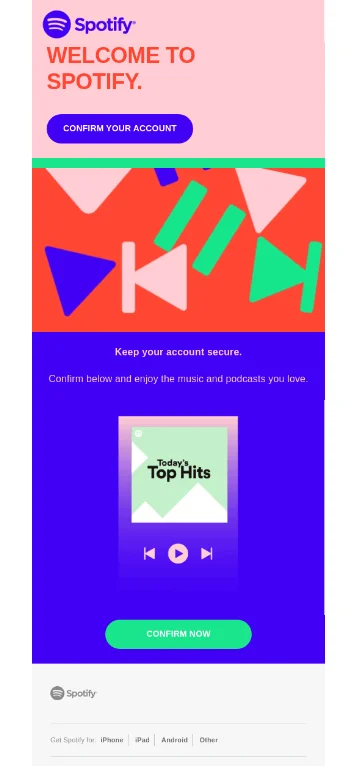
Spotify targets users who have not yet subscribed to the Premium plans with emails, such as these:

You can consider several effective email marketing examples like this one from Spotify, the Year in Review sent just before the new year begins.
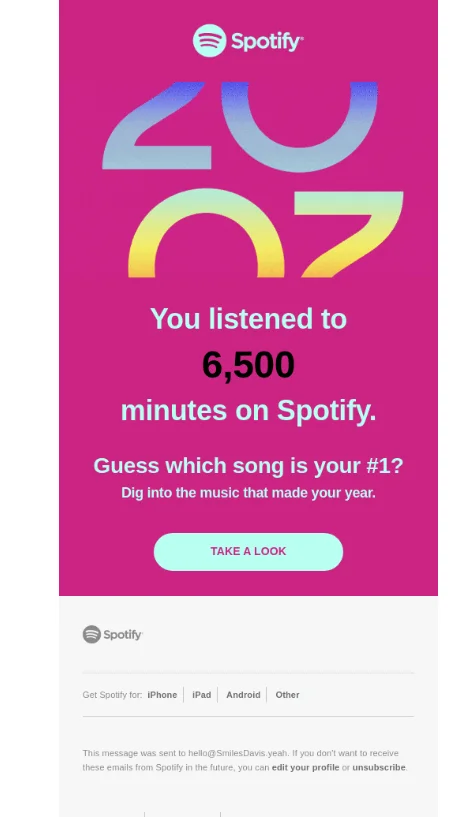
12. Test and analyze email campaign performance
Testing is the key to email optimization and boosting your email campaign’s ROI. And, proving the campaign ROI is the secret to justifying your email marketing budget.
Here are some tips to do A/B testing right:
- Test different elements: With a good email marketing tool, such as Omnisend, you can test various elements of the email including:
- Subject lines (different discounts, with/without emojis, with/without subscriber name, etc)
- Calls to action
- Email content, including discounts, headers, image-to-text ratio
- Sender’s name and email address
- Preheaders
- The time of sending
- Test one variable at a time: To accurately assess the impact of each change, test one variable at a time.
- Segment your audience: Segment your audience based on relevant criteria, such as demographics, behavior, or past engagement.
- Create variations: Develop multiple versions of the element you want to test. For instance, if you’re testing subject lines, create two or more subject lines.
- Determine your sample size: The larger your sample size, the more accurate the results.
- Track and measure results: Use email marketing analytics tools to track important metrics, such as open rates, click-through rates, conversions, and any other relevant indicators.
Once you identify the winning variation, implement it in your main email campaign. In addition to A/B testing, you should also track your campaign metrics to know if your emails need tweaking.
What metrics should you track?
While most marketers track open and click rates, there are other metrics that are vital to your campaign’s success, such as:
- Email marketing/campaign ROI
- Subscriber lifetime value
- Email deliverability
- Unsubscribe rate
- Conversion rate
- Bounce rate
- Email list growth
- Cost of acquistion
- Email device usage
- Sales generated by campaign
- Top-performing segments and workflows
Wrapping up
From crafting compelling subject lines and using personalization to growing an engaged list of subscribers and A/B testing, these 12 email optimization strategies will help you take your email campaigns to the next level.
Note that email optimization is an ongoing, iterative process. Regularly conduct A/B tests and track campaign performance to refine your email campaigns over time.
Now that you are familiar with email marketing best practices, you can start implementing these email optimization strategies to maximize the performance of your emails.
Source from Omnisend
Disclaimer: The information set forth above is provided by Omnisend independently of Alibaba.com. Alibaba.com makes no representation and warranties as to the quality and reliability of the seller and products.
